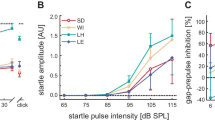Abstract
Experimental seizures may be evoked in animals by electrical, chemical, or sensory technics. Sound is the most frequently employed sensory stimulus. With sufficient stimulus intensity, all the technics produce a maximal seizure characterized by a sequence of tonic flexion and tonic extension; the pattern of submaximal seizure activity varies with the type of evoking stimulus and its intensity (1,2). Because of their simplicity and reliability, electroshock and chemoshock tests have been widely employed to study the convulsive process and to evaluate drug activity. Several tests, e.g., maximal electroshock seizure and low frequency electroshock seizure tests, are well standardized and have a reasonable neurophysiological explanation (1,2).
Access this chapter
Tax calculation will be finalised at checkout
Purchases are for personal use only
Preview
Unable to display preview. Download preview PDF.
Similar content being viewed by others
References
Fink, G.B. and E.A. Swinyard, 1959. Modification of maximal audiogenic and electroshock seizures in mice by psychopharma-cologic drugs. Journal of Pharmacology and Experimental Therapeutics. 127: 318–324.
Swinyard, E.A., A.W. Castellion, G.B. Fink and L.S. Goodman, 1963. Some neurophysiological and neuropharmacological characteristics of audiogenic-seizure-susceptible mice. Journal of Pharmacology and Experimental Therapeutics. 140:375–384.
Bevan, W., 1955. Sound precipitated convulsions: 1947–1954. Psychological Bulletin. 52:473–504.
Fuller, J.L. and R.E. Wimer, 1966. Neural, sensory and motor functions. In: E.L. Green (Ed.), Biology of the Laboratory Mouse, McGraw-Hill, New York, pp. 609–629.
Vicari, E.M., 1951. Fatal convulsive seizures in the DBA mouse strain. Journal of Psychology. 32:79–97.
Suter, C., W.O. Klingman, O.W. Lacy, D. Boggs, R. Marks and C.B. Coplinger, 1958. Sound-induced seizures in animals. Neurology. 8:117–120.
Iturrian, W.B. and G.B. Fink, 1967. Conditioned convulsive reaction. Federation Proceedings. 26:736.
Frings, H., M. Frings and A. Kivert, 1951. Behavior patterns of the laboratory mouse under auditory stress. Journal of Mammalogy. 32: 60–72.
Frings, H. and M. Frings, 1952. Audiogenic seizures in the laboratory mouse. Journal of Mammalogy. 33:80–87.
Fuller, J.L. and F.H. Sjursen Jr., 1967. Audiogenic seizures in eleven mouse strains. Journal of Heredity. 58:135–140.
Al-Hachim, G.M. and G.B. Fink, 1967. Effect of DDT or para-thion on audiogenic seizures of offspring from DDT or parathion treated mothers. Psychological Reports. 20:1183–1187.
Iturrian, W.B., and G.B. Fink, 1968. Effect of age and condition-test interval (days) on an audio-conditioned convulsive response in CF #1 mice. Developmental Psychobiology. 1:230–235.
Henry, K.R., 1967. Audiogenic seizure susceptibility induced in C57BL/6J mice by prior auditory exposure. Science. 158:938–940.
Fuller, J.L. and R.L. Collins, 1968. Temporal parameters of sensitization for audiogenic seizures in SJL/J mice. Developmental Psychobiology. 1:185–188.
Iturrian, W.B. and G.B. Fink, 1968. Comparison of bedding material: Habitat preference of pregnant mice and repoductive performance. Laboratory Animal Care. 18:160–164.
Iturrian, W.B. and G.B. Fink, 1968. Effect of noise in the animal house on seizure susceptibility and growth of mice. Laboratory Animal Care. 18:557–560.
Iturrian, W.B. and G.B. Fink, 1969. Influence of age and brief auditory conditioning upon experimental seizures in mice. Developmental Psychobiology. 2:10–15.
Iturrian, W.B., 1970. Effect of noise on experimental seizures and growth of weanling mice. IV International ILAR-ICLA Symposium — In: W.L. Gay (Ed.), Defining the Laboratory Animal in the Search for Health. National Academy of Sciences, Washington, D.C. In press.
Castellion, A.W., Swinyard, E.A. and L.S. Goodman, 1965. Effect of maturation on the development and reproducibility of audiogenic and electroshock seizures in mice. Experimental Neurology. 13:206–217.
Vernadakis, A. and D.M. Woodbury, 1965. Effects of diphenyl-hydantoin on electroshock seizure thresholds in developing rats. Journal of Pharmacology and Experimental Therapeutics. 148:144–150.
Plotnikoff, N., 1963. A neuropharmacological study of escape from audiogenic seizures. Colloquium Internationale Recherche Sciences (Paris), 112:429–443.
Author information
Authors and Affiliations
Editor information
Editors and Affiliations
Rights and permissions
Copyright information
© 1970 Plenum Press, New York
About this chapter
Cite this chapter
Fink, G.B., Iturrian, W.B. (1970). Influence of Age, Auditory Conditioning, and Environmental Noise on Sound-Induced Seizures and Seizure Threshold in Mice. In: Welch, B.L., Welch, A.S. (eds) Physiological Effects of Noise. Springer, Boston, MA. https://doi.org/10.1007/978-1-4684-8807-4_18
Download citation
DOI: https://doi.org/10.1007/978-1-4684-8807-4_18
Publisher Name: Springer, Boston, MA
Print ISBN: 978-1-4684-8809-8
Online ISBN: 978-1-4684-8807-4
eBook Packages: Springer Book Archive



